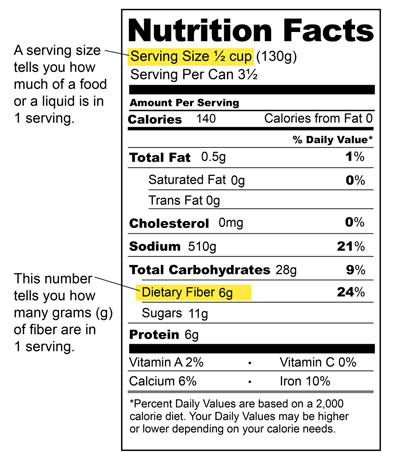Eating a High-Fiber Diet
Eating a High-Fiber Diet
Fiber is what gives strength and structure to plants. Most grains, beans, vegetables, and fruits contain fiber. Foods rich in fiber are often low in calories and fat, and they fill you up more. They may also reduce your risks for certain health problems. To find out the amount of fiber in canned, packaged, or frozen foods, read the Nutrition Facts label. It tells you how much fiber is in one serving.
Types of fiber and their benefits
There are two types of fiber: insoluble and soluble. They both aid digestion and help you maintain a healthy weight.
Insoluble fiber. This is found in whole grains, cereals, certain fruits and vegetables such as apple skin, corn, and carrots. Insoluble fiber may prevent constipation and reduce the risk for certain types of cancer. It is called insoluble because it does not dissolve in water.
Soluble fiber. This type of fiber is in oats, beans, and certain fruits and vegetables such as strawberries and peas. Soluble fiber can reduce cholesterol, which may help lower the risk for heart disease. It also helps control blood sugar levels.
Look for high-fiber foods
Try these foods to add fiber to your diet:
Whole-grain breads and cereals. Try to eat 6 to 8 ounces a day. Include wheat and oat bran cereals, whole-wheat muffins or toast, and corn tortillas in your meals.
Fruits. Try to eat 2 cups a day. Apples, oranges, strawberries, pears, and bananas are good sources. (Note: Fruit juice is low in fiber.)
Vegetables. Try to eat at least 2.5 cups a day. Add asparagus, carrots, broccoli, peas, and corn to your meals.
Beans. One cup of cooked lentils gives you over 15 grams of fiber. Try navy beans, lentils, and chickpeas.
Seeds. A small handful of seeds gives you about 3 grams of fiber. Try sunflower or chia seeds.
Keep track of your fiber
Keep track of how much fiber you eat. Start by reading food labels. Then eat a variety of foods high in fiber. As you start to eat more fiber, ask your healthcare provider how much water you should be drinking to keep your digestive system working smoothly.
Aim for a certain amount of fiber in your diet each day. If you are a woman, that amount is between 25 and 28 grams per day. Men should aim for 30 to 33 grams per day. After age 50, your daily fiber needs drop to 22 grams for women and 28 grams for men.
Before you reach for the fiber supplements, think about this. Fiber is found naturally in healthy whole foods. It gives you that feeling of fullness after you eat. Taking fiber supplements or eating fiber-enriched foods will not give you this full feeling.
Your fiber intake is a good measure for the quality of your overall diet. If you are missing out on your daily amount of fiber, you may be lacking other important nutrients as well.
Updated:
October 09, 2017
Reviewed By:
Horowitz, Diane, MD,Wilkins, Joanna, RD, CD
